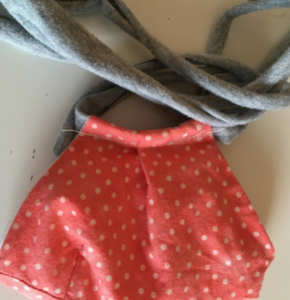Last week I’ve finally succumbed to the need to make facemasks after the announcement of the upcoming change in Government guidance that face coverings will be mandatory in shops from 24th July.
I dabbled in face masks a earlier in the pandemic, but as we have not been leaving the house except for supermarket shopping and outdoor exercise, they felt a bit unnecessary.
So unsurprisingly there isn’t a one size fits all pattern, all the variations in our human faces are infinite, that would be impossible.
There are heaps of free patterns on the internet and I downloaded a few to take a look. Each one has pros and cons to style, fitting and comfort.
Sewing Bee judge Patrick Grant has joined forces with lots of other well known sewists to bring together with different masks and techniques to encourage sewers to sew face masks for the community at The Big Community Sew. https://www.bigcommunitysew.co.uk/
The simplest face mask to sew is the pleated mask. https://youtu.be/tjcBX52tZn4 This video from Tilly & the Buttons shows you how, this version has a little pocket for you to insert a filter.
Olsen Mask – https://www.wikihow.com/Make-a-Mask-Using-the-Olsen-Mask-Pattern
This mask and variations of it is probably one of the most common ones. The shaping helps keep the mask close to your nose, and it has seam right down the centre of the face to create the shaping.
Twig and Tale – https://www.twigandtale.com/products/fabric-face-mask
There are a few options and sizes from Twig & Tale, making them suitable for smaller and larger faces. There are lots of pattern pieces and really comprehensive instructions. There is a pleated mask, but it has a bit more shaping than the rectangular pleated masks to achieve a better fit over the side of the face. I found this pattern a bit more complex than I would have wanted with little fiddly pattern pieces.
Sew it with Di – http://www.sew-it.biz/smile-masks/4594900488 – for the basic face mask, scroll down past the smiles mask.



This is the one I opted to make, but instead of elastic loops I made ties from unfinished strips of an upcycled jersey t-shirt. Di has also to got a pattern for a smiles mask which has a transparent window for those who reply on lipreading to communicate.
Dhurta Davies – https://dhuratadavies.com/blogs/things-i-make-and-do/free-face-mask-pattern-and-tutorial
I discovered this version after I’d made mine. It is a similar style but comes in multiple sizes to fit different sized faces. There are addendum to add wire and filters too.
3D mask – https://youtu.be/Z7q6ou5keGE This is another one I discovered after I had finished mine – but the feedback I’ve seen online for this version is all really good – there is a YouTube video (which is in Portuguese) and a downloadable pattern in the comments under the video, but it looks relatively easy to follow.
The things I have considered when choosing/making my masks were:
Fitting, close around the nose – being a glasses wearer this prevents them from steaming up.
Ease of making, wearing and care – masks are not something I want to spend too much time and energy on. I want them to be easy to make, without fiddly nose wires or filter pockets, comfy and easy to wear and easy to wash at 60° to kill the virus!
Ties versus elastic – ties are better for me, I think because I wear glasses but also because I’ve got one sticky out ear. I made my ties from strips of cut up from an old jersey t-shirt, so they still have some stretch and are comfortable. Also all the masks I have tried on with elastic loops around the ears are too big for my ear position. I think I must have forward ears.
Filtration properties of the fabric – ideally you want to use a fabric with a dense a weave as possible to minimise the droplets that can pass through your mask. A quilting cotton is ideal, the higher thread count the better. In my research I discovered that silk had good results in filtering out droplets. I had some silk organza in my stash that I had used previously as an interfacing for bridalwear, so I used that as a middle layer in the masks.
Minimised holes over the mouth and nose – to maximize the ability of the fabric to filter any moisture, I didn’t want a seam running over the mouth and nose, which is why I like the Sew it with Di one as it has darts at the nose and chin to create shaping but no seam over the mouth and nostrils. Ditto for embroidered and decorated masks: the more times the fabric is pierced with a needle, the more holes are opened in the fabric.
Breathability of the fabric – using natural fibres rather than synthetics. Cotton rather than polycotton or polyester. If you are using upcycled fabrics check the fibre content on the care label. This is one of the reasons that many people are finding the masks claustrophobic.
Stiffness of the fabric – Another reason that people are finding the masks difficult to breath in is that there isn’t enough room around the mouth and nose and the fabric is very close or that the fabric is soft and is sucking towards the face on an in breath. Using a good quality quilting cotton should help with this, rather than a softer jersey fabric.
As time goes by and we continue to have to wear face masks I may start to experiment with others and making them to match my outfits. They are definitely a good scrap busing project!
Alison xx